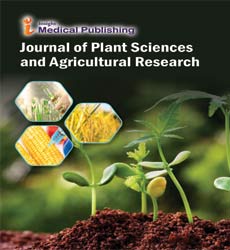Enhancing Plant Immunity for Eco-Friendly Agriculture
Chao Wang*
Department of Food Science, Zhejiang University, Hangzhou, China
- *Corresponding Author:
- Chao Wang
Department of Food Science, Zhejiang University, Hangzhou,
China,
E-mail: wang_c@zudu.cn
Received date: August 23, 2024, Manuscript No. IPJPSAR-24-19140; Editor assigned date: August 26, 2024, PreQC No. IPJPSAR-24-19140 (PQ); Reviewed date: September 09, 2024, QC No. IPJPSAR-24-19140; Revised date: September 17, 2024, Manuscript No. IPJPSAR-24-19140 (R); Published date: September 24, 2024, DOI: 10.36648/ipjpsar.8.3.151
Citation: Wang C (2024) Enhancing Plant Immunity for Eco-Friendly Agriculture. J Plant Sci Agri Res Vol.8 No.3: 151.
Description
Plant immunity, also known as plant defense or plant resistance, refers to the sophisticated mechanisms that plants have evolved to detect and respond to potential threats from pathogens such as fungi, bacteria, viruses, nematodes and other pests. Just like animals, plants are constantly under attack from a wide range of microbial invaders seeking to colonize their tissues and extract nutrients. However, unlike animals, plants lack a mobile immune system and must rely on innate defense mechanisms encoded in their genomes to protect themselves from pathogens.
One of the first lines of defense in plant immunity is the recognition of Pathogen-Associated Molecular Patterns (PAMPs) by Pattern Recognition Receptors (PRRs) located on the plant cell surface. PAMPs are conserved molecular structures present in pathogens, such as bacterial flagellin or fungal chitin, that are essential for their survival and pathogenicity. When PRRs recognize these PAMPs, they trigger a series of intracellular signaling events, known as PAMP-Triggered Immunity (PTI), leading to the activation of defense responses aimed at restricting pathogen invasion and proliferation.
However, pathogens have evolved sophisticated strategies to evade or suppress PTI, prompting plants to deploy a second layer of defense known as Effector-Triggered Immunity (ETI). ETI is initiated upon the recognition of specific pathogen effectors, which are virulence factors secreted by pathogens to manipulate host cell processes and promote infection. In plants, Resistance (R) proteins encoded by Resistance (R) genes recognize these effectors and trigger strong defense responses, including the Hypersensitive Response (HR), a localized cell death reaction that restricts pathogen spread. The molecular mechanisms underlying plant immunity are highly complex and involve a network of interconnected signaling pathways and regulatory components. Key players in plant immunity include Mitogen- Activated Protein Kinases (MAPKs), calcium signaling molecules, Reactive Oxygen Species (ROS), phytohormones such as Salicylic Acid (SA), Jasmonic Acid (JA) and Ethylene (ET), as well as transcription factors and defense-related genes. These components work in concert to orchestrate the activation of defense responses customized to combat specific pathogens and environmental cues.
Plant immunity is not only effective against microbial pathogens but also plays a role in defense against herbivores and other pests. In response to herbivore attack, plants can release Volatile Organic Compounds (VOCs) that attract natural enemies of herbivores, such as predatory insects or parasitoids, thereby indirectly defending themselves against herbivory. Moreover, plants can produce toxic secondary metabolites, such as alkaloids, terpenoids and phenolics, that deter herbivores or reduce their feeding efficiency.
Understanding and manipulating plant immunity have significant implications for agriculture, as it offers opportunities to develop novel strategies for crop protection and improvement. Breeding for disease resistance is a key approach in modern plant breeding programs, where breeders aim to introgress R genes from wild relatives or related species into cultivated crops to enhance their resistance against pathogens. In addition, genetic engineering techniques, such as RNA interference (RNAi) and genome editing, can be used to modulate plant immunity genes and confer resistance to specific pathogens.
However, the arms race between plants and pathogens continues to evolve, with pathogens evolving new virulence factors and strategies to overcome plant defenses. Therefore, ongoing research efforts focus on elucidating the molecular mechanisms of plant immunity, identifying novel defense genes and pathways and developing sustainable disease management strategies that minimize reliance on chemical pesticides and promote ecological balance.
Conclusion
Plant immunity is a fascinating and dynamic field of study that encompasses the intricate mechanisms by which plants defend themselves against pathogens and pests. By unraveling the complexities of plant-pathogen interactions and harnessing the power of plant immunity, researchers aim to develop resilient crop varieties with enhanced disease resistance and sustainability, ensuring food security and environmental health for future generations.
Open Access Journals
- Aquaculture & Veterinary Science
- Chemistry & Chemical Sciences
- Clinical Sciences
- Engineering
- General Science
- Genetics & Molecular Biology
- Health Care & Nursing
- Immunology & Microbiology
- Materials Science
- Mathematics & Physics
- Medical Sciences
- Neurology & Psychiatry
- Oncology & Cancer Science
- Pharmaceutical Sciences
